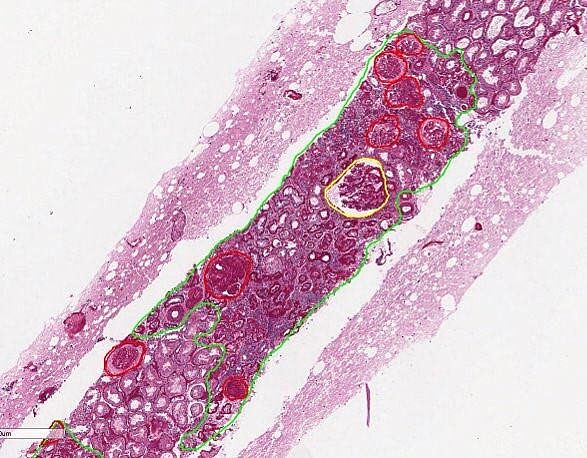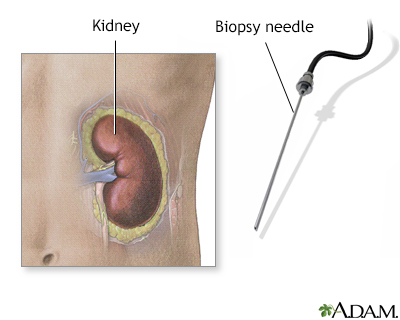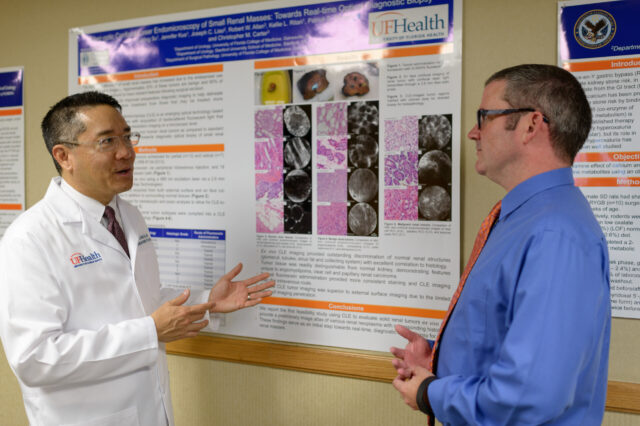Definition
A kidney biopsy is the removal of a small piece of kidney tissue for examination.
Alternative Names
Renal biopsy; Biopsy - kidney
How the Test is Performed
A kidney biopsy is done in the hospital. The two most common ways to do a kidney biopsy are percutaneous and open. These are described below.
Percutaneous biopsy
Percutaneous means through the skin. Most kidney biopsies are done this way. The procedure is usually done in the following way:
- You may receive medicine to make you drowsy.
- You lie on your stomach. If you have a transplanted kidney, you lie on your back.
- The provider marks the spot on the skin where the biopsy needle is inserted.
- The skin is cleaned.
- Numbing medicine (anesthetic) is injected under the skin near the kidney area.
- The provider makes a tiny cut in the skin. Ultrasound images are used to find the proper location. Sometimes another imaging method, such as CT, is used.
- The provider inserts a biopsy needle through the skin to the surface of the kidney. You are asked to take and hold a deep breath as the needle goes into the kidney.
- If the provider is not using ultrasound guidance, you may be asked to take several deep breaths. This allows the doctor to know the needle is in place.
- The needle may be inserted more than once if more than one tissue sample is needed.
- The needle is removed. Pressure is applied to the biopsy site to stop any bleeding.
- After the procedure, a bandage is applied to the biopsy site.
Open biopsy
In some cases, your doctor may recommend a surgical biopsy. This method is used when a larger piece of tissue is needed.
- You receive medicine (anesthesia) that allows you to sleep and be pain-free.
- The surgeon makes a small surgical cut (incision).
- The surgeon locates the part of the kidney from which the biopsy tissue needs to be taken. The tissue is removed.
- The incision is closed with stitches (sutures).
After percutaneous or open biopsy, you will likely stay in the hospital for at least 12 hours. You will receive pain medicines and fluids by mouth or through a vein (IV). Your urine will be checked for heavy bleeding. A small amount of bleeding is normal after a biopsy.
Follow instructions about caring for yourself after the biopsy. This may include not lifting anything heavier than 10 pounds (4.5 kilograms) for 2 weeks after the biopsy.
How to Prepare for the Test
Tell your health care provider:
- About medicines you are taking, including vitamins and supplements, herbal remedies, and over-the-counter medicines
- If you have any allergies
- If you have bleeding problems or if you take blood-thinning medicines such as warfarin (Coumadin), clopidogrel (Plavix), dipyridamole (Persantine), fondaparinux (Arixtra), apixaban (Eliquis), dabigatran (Pradaxa), or aspirin
- If you are or think you might be pregnant
How the Test will Feel
Numbing medicine is used, so the pain during the procedure is often slight. The numbing medicine may burn or sting when first injected.
After the procedure, the area may feel tender or sore for a few days.
You may see bright, red blood in the urine during the first 24 hours after the test. If the bleeding lasts longer, tell your provider.
Why the Test is Performed
Your doctor may order a kidney biopsy if you have:
Normal Results
A normal result is when the kidney tissue shows normal structure.
What Abnormal Results Mean
An abnormal result means there are changes in the kidney tissue. This may be due to:
References
Salama AD, Cook HT. The renal biopsy. In: Yu ASL, Chertow GM, Luyckx VA, Marsden PA, Karl S, Philip AM, Taal MW, eds. Brenner and Rector's The Kidney. 11th ed. Philadelphia, PA: Elsevier; 2020:chap 26.
Topham PS, Chen Y. Renal biopsy. In: Feehally J, Floege J, Tonelli M, Johnson RJ, eds. Comprehensive Clinical Nephrology. 6th ed. Philadelphia, PA: Elsevier; 2019:chap 6.





